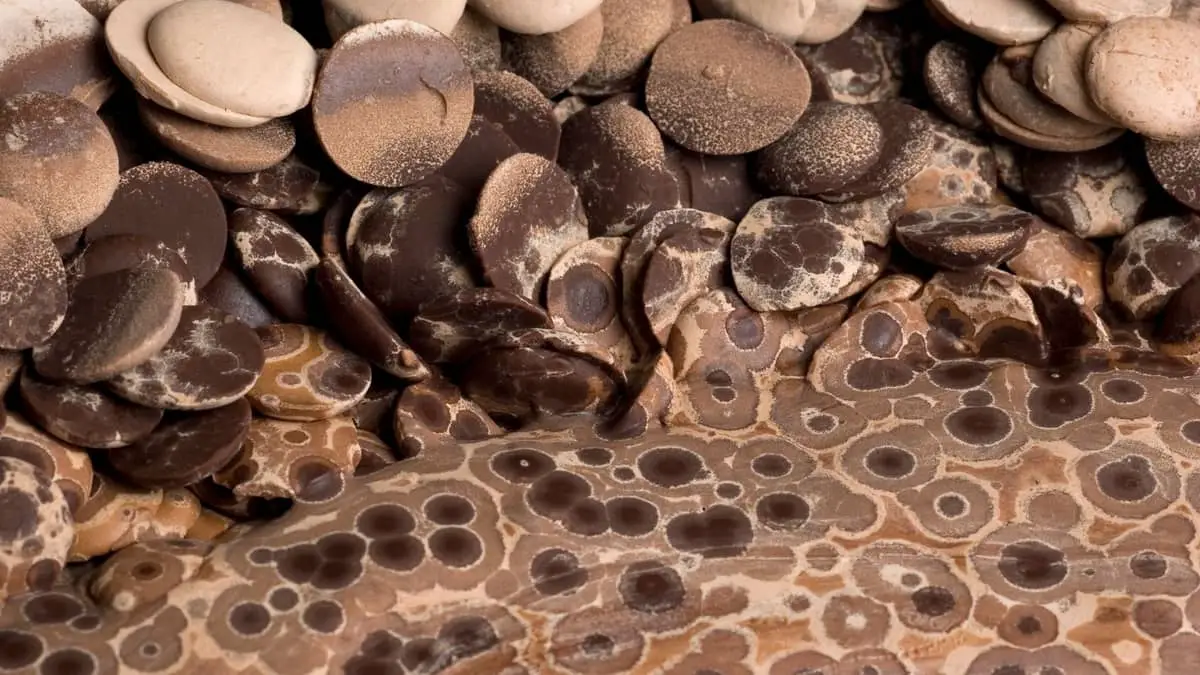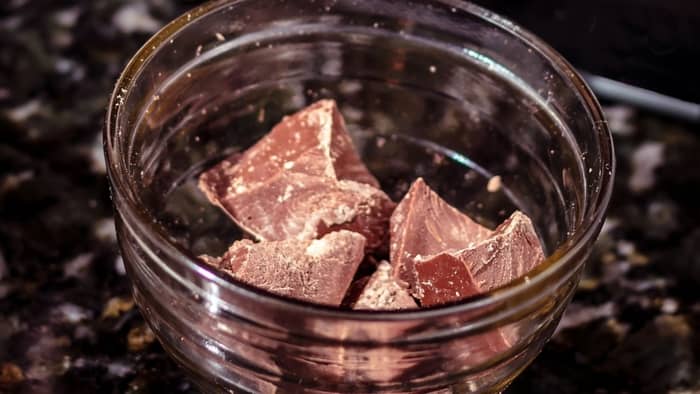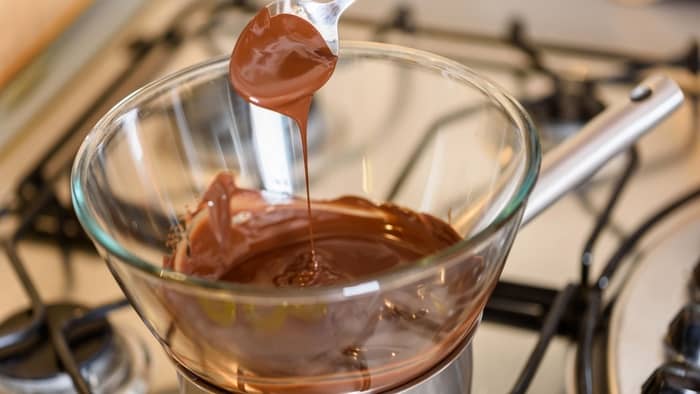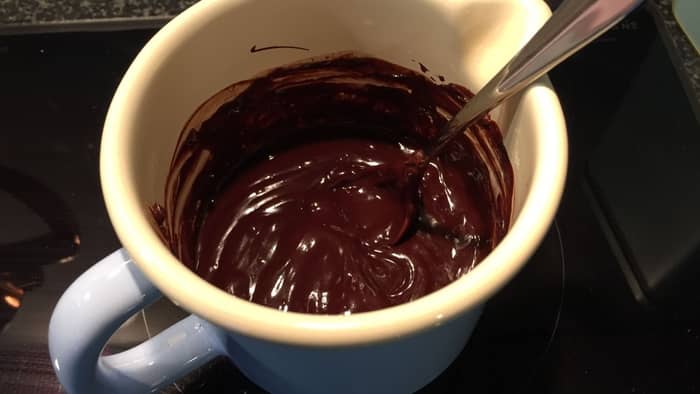Last Updated on February 3, 2023
If you are searching for how to fix chocolate bloom, look no further! We have 3 easy methods that will remove chocolate bloom immediately!
You can use a microwave or double boiler which are both quick and easy methods to use. However, if you want a guarantee, you will have to re-temper the chocolate. But, fear not, as we have an in-depth guide on doing so that even the most novice of chocolatiers will be able to follow!
Keep reading to learn how to fix chocolate bloom and what it is.
What is Blooming Chocolate?
Chocolate bloom (also called bloom chocolate) comes in two main forms; fat bloom and sugar bloom. While both cause the chocolate to change in appearance, they occur in different ways and for different reasons.
Bloom forms a whitish coating on the surface of the chocolate that affects the appearance and sometimes even the texture of the chocolate. It usually occurs when the chocolate has been exposed to unfavorable storage conditions as well as the chocolate exceeding its best-by date.
What Causes Fat Bloom Chocolate?
Fat bloom occurs when the cocoa butter in the chocolate separates from the other ingredients. This mostly happens for two reasons.
The first is that the chocolate wasn’t tempered correctly. Tempering chocolate is a method that is used where chocolate is melted and re-solidified. This process helps evenly distribute the cocoa butter crystals to create a more stable product with a shiny appearance and a sharp snap.
The second reason fat bloom occurs is when the chocolate was stored at too high temperatures, like in a car, inside a bag, or in direct sunlight.
What essentially happens when either of these reasons takes place is that the cocoa butter crystals melt and separate from the other ingredients. Then, it moves to the surface of the chocolate where it forms a white layer. During this process, obviously, the texture of the chocolate will also be affected.
Learn more about Liquid Eggs Vs Real Eggs – What’s The Difference?
What Causes Sugar Bloom Chocolate?
Sugar bloom chocolate differs slightly from fat bloom. It usually occurs when chocolate has a temperature shock or when it has been stored in very humid and moist areas. This causes the chocolate to get a very grainy texture and rough white surface (unlike the smooth white hue that fat bloom causes).
Temperature shock occurs when you transfer chocolate from a very hot area to a very cold area. For example, you move the melted chocolate from a hot car into the fridge to re-solidify. Condensation forms on the surface of the chocolate which then reacts with the sugar inside, causing the change in texture and appearance.
And, that brings us to our second culprit, humidity (which links to condensation forming). Any humid area will cause the moisture to help dissolve the sugar inside the chocolate. Once it re-crystallizes, the sugar crystals change the surface of the chocolate.
Is Chocolate Bloom Safe to Eat?
Now that you know what causes chocolate bloom, you will want to know if it is safe to eat. Fortunately, chocolate with bloom is perfectly safe to eat. Both fat bloom and sugar bloom in chocolate are safe to consume.
While it may look funny, it will not make you sick if you eat it, and can be consumed as normal. However, in cases of extreme bloom, the texture and flavor of the chocolate may change. While it may not taste good at this point, it is still safe to consume.
While often blooming chocolate will taste absolutely fine, sometimes it will develop a grainy, waxy, or crumbly. This is more likely to happen on cheap chocolate than it is to happen on high-quality chocolate.
One of the most common instances of bloom chocolate is in chocolate chips. Fortunately, you can still use them in your recipes and get delicious results.
Chocolate Bloom vs Mold
While bloom in chocolate is safe and normal, mold is not. However, for some people, it may be tricky to tell the two apart without knowing about chocolate bloom. Fortunately, some distinguishable traits allow you to tell the difference between mold and bloom.
While both mold and bloom can appear white, the texture is different. Bloom can occur in gray or white streaks on your chocolate and have a chalky, slick texture. Mold can be white with green or blue spots with a fuzzy texture.
Mold will have a bad smell to it whereas bloom has no smell distinguishable from chocolate. Chocolate with bloom often tastes just fine while mold will have a bad flavor.
Bloom in chocolate is common and can happen to essentially all types of chocolate. On the other hand, it is very rare for chocolate to get mold. Chocolate chips and bars will very likely never grow mold, but chocolate truffles, cookies, cakes, brownies, and other desserts can.
If there is any mold on your chocolate or any baked goods with chocolate, throw it out immediately. Unlike chocolate with bloom, chocolate with mold or chocolate baked goods with mold can not be saved and can make you sick.
How to fix chocolate bloom can be done by tempering or heating in the microwave or a double boiler. It is a relatively simple process to do.
For best results, store your chocolate in a cool, dry location. It is important to keep your chocolate away from direct sunlight as it will melt and create a mess.
How to Fix Chocolate Bloom
Fixing bloomed chocolate is very difficult, but not impossible. In short, you can fixsugar-bloomm chocolate andfat-bloomm chocolate by melting it and re-solidifying it. This method helps re-introduce the sugar or fat crystals back into the chocolate and once again create a stable product.
Method 1: Using a Microwave to Fix Bloom
This is arguably the quickest method you can use, which is its biggest and honestly only pro. The cons are that you run the risk of causing the chocolate to seize and you aren’t guaranteed to fix bloomed chocolate. But, it can work in a pinch!
To use this method, simply add your blooming chocolate into a microwave-safe bowl. Make sure the bowl is completely free of fat (only use glass bowls or stainless steel bowls).
Place the bowl inside the microwave and heat the chocolate in 30-second intervals. Stir the chocolate using a clean silicone spatula. Continue these steps until the chocolate has completely melted.
Transfer the melted chocolate to a cold glass or metal bowl and allow it to cool at room temperature. Once it has cooled a bit you can pour it into the mold of your choice and allow it to set completely (at room temperature).
Method 2: Using a Double Boiler
This method works in the same way a microwave would and is also how chocolate is tempered. But, what makes it different from tempered chocolate is that you don’t check the temperatures. It is a much quicker method that has a better chance of working compared to a microwave.
To make a double boiler, add some water to a small pot and bring it to a simmer. Add the bloomed chocolate into a large glass bowl and place it over the simmering water.
A key here is to ensure you don’t allow moisture (from the steaming water) to enter the chocolate. Every time you remove the glass bowl from the pot, place a lid on the pot to keep the steam inside.
You can also work in about 30-second intervals to ensure the chocolate doesn’t overheat and seize. During each interval, stir the chocolate so that it melts evenly.
Once melted, allow it to cool at room temperature before pouring it into a mold and allowing it to set completely.
Method 3: Tempering Chocolate
This is the method that is almost guaranteed to work. Tempering chocolate helps create stable crystals. By remelting and resetting them through the use of precise temperatures, you can completely fix any type of bloom.
Use the double boiler to help slowly and evenly heat and melt the bloomed chocolate. Once the chocolate has been fully melted, it should reach a temperature of 105°F for white and milk chocolate, and 110-120°F for dark chocolate. This will ensure that all of the different types of crystals have been melted.
Then, the chocolate must be cooled to 80-82°F. After it has reached that, it can be slightly reheated to between 85-87°F for white and milk chocolate, and 88-91°F for dark chocolate. This process allows the right crystals to form and create stable chocolate.
Can You Reheat Melted Chocolate?
You can reheat melted chocolate for baking purposes if it begins to harden. If it cools to around 84 to 86 degrees Fahrenheit, you can still warm it up to a liquid consistency and achieve a tempered finish. However, if the chocolate solidifies, you will have to retemper it and start over.
However, be careful reheating your chocolate as overheated chocolate may lose its shine and develop a thick texture that is difficult to work with. Even if you are unable to reheat your chocolate to temper, you can still add it to your baked goods and it will taste delicious.
How to Prevent Bloom Chocolate
It is incredibly easy to prevent sugar blooming or fat blooming in chocolate. Much easier than even considering how to fix chocolate bloom! All you have to do is store the chocolate in a cool dry place away from any direct sunlight, temperature changes, and moisture or humidity.
How to Fix Chocolate Bloom – It Has Never Been Easier To Fix!
What did we tell you? Easiest methods ever! Share this informative article with your family and friends who also struggle with fixing chocolate bloom, and let us know in the comments below if you have any questions!

Lindy Van Schalkwyk is a culinary specialist with a background in Advanced Cooking, Advanced Pâtisserie, Media Communications and Nutrition. She has gained invaluable experience in the culinary industry having worked in some of the top restaurants in Africa in 2016 and 2017. Her expertise in nutrition has enabled her to develop recipes for special dietary needs. In 2018, Lindy began working in the Food Media industry, focusing on recipe development, recipe writing, food writing and food styling.




